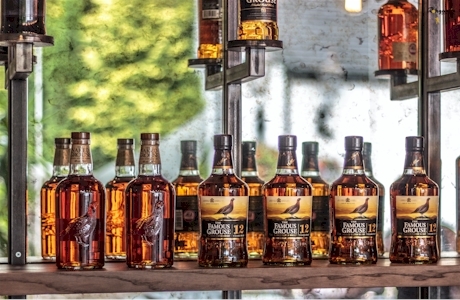SECRETS OF BLENDED SCOTCH
Deep, dark secrets revealed about Blended Scotch Whisky!
Single malt Scotch whisky is not the only drink in the house. Blends comprise over 90% of worldwide Scotch sales. The choices are legion, ranging from low cost, high-grain grocery store blends to high-end aged malt blends.
Blended Scotch Whisky:
Scotch blending dates back to the late 1800s invention of the column still by Aeneas Coffey, an excise tax collector and inventor seeking ways to make whisky from non-malted grains (corn, green barley, wheat, rice), and to increase distillation output and speed. The resulting whiskies were lighter and cheaper, with broader appeal, and within ten years, blending grain and malt whisky was commonplace. Blending pioneers Andrew Usher II, followed by James Chivas, Johnny Walker, and Tommy Dewar, among many others, began shipping blended Scotch across the globe.
Today, Scotch blending is an art, creating unique Scotch expressions with lighter but more predictable flavors, greater variety, and lower cost. Standard blended Scotch must contain at least one single malt in the mix (unless its blended grain Scotch), and better blends often include 20% to 50% malt. Master blenders often select specific malts to impart unique flavor components, plus one or more grain whisky to achieve the desired end product. As with all Scotch, the component whiskies, or the final blend itself, must be aged for 3 or more years. AnyStandard age statement on the bottle must represent the youngest whisky in the mix.
Examples of high-grain, low-malt blends include Ballantine’s, J&B, and Whyte & Mackay. Generally simple and light, these whiskeys are usually less expensive and more suited to cocktails or as an introduction to Scotch. High-malt blends include venerable names such as Johnny Walker, Chivas Regal, Teachers, and Famous Grouse, exhibiting more intensive malt flavors and generally higher in quality and usually higher in price. Blends like Johnny Walker Gold and Chivas Regal 18, each with high malt content are perennial award winners appreciated even by the staunchest single malt devotee. There are even some super-expensive and rare 30 and 50-year-old blends.
Blended Malt (aka “Vatted” or “Pure” Malt) Scotch Whisky:
Blended malt combines single malts from multiple distilleries, most frequently to achieve a specific flavor profile or to provide a value-centric option. Many are matured similarly to single malts and exhibit equivalent quality. Examples of blended malt scotch include Monkey Shoulder, Black Bottle, Johnny Walker Green 15, and so many more.
Blended Grain Scotch
Although single grain is common in US, Irish, and Japanese whiskeys, Scotch producers have experienced little success. Most grain Scotch lacks intensity resulting in blends that are too simple for most Scotch enthusiasts. One rare exception, Compass Box Hedonism, is blended from some of the highest quality grain whiskies available. A consistent award winner described as “rich and elegant,” Hedonism boasts flavors of vanilla, toffee, coconut, and cocoa.” Other successful grain Scotches are produced by Strathcolm, Auchavan, and Duncan Taylor.
The Secret’s in the Blend
Producers generally hold the recipes to their blends “close to the vest.” Often passed down through generations, some are so secret that even the employees can’t know. For Scotch nerds like me, half the fun of drinking blended Scotch is trying to identify the component malts. From our army of secret scotch investigators, we’ve been able to piece together some of these mysterious blends. Don’t ask how we know, as lives could be at risk!
This list is by no means comprehensive, and although we can’t guarantee it’s accuracy, we do believe our sources to be generally correct. You be the judge!
- Ballantine’s (Blended)
Glendronach, Imperial, The Macallan, Miltonduff, Scapa - Bell’s (Blended)
Blair Athol, Caol Ila, Dufftown, Inchgower, Linkwood, Oban - Black and White (Blended)
Dalwhinnie - Black Bottle (Blended Malt)
Ardbeg, Bowmore, Bunnahabhain, Caol Ila, Laphroaig - Buchanan’s (Blended)
Glenkinchie - Campbeltown (Blended)
Springbank - Chivas Regal (Blended)
Allt-a-Bhainne, Benriach, Glenlivet, The Macallan, Strathisla - Clan Campbell (Blended)
Aberlour, Edradour - Compass Box Hedonism (Blended Grain)
Some combination of Cameron Bridge, Carsebridge, Cambus, Port Dundas,r Dumbarton - Cutty Sark (Blended)
Glenrothes, The Macallan, Tamdhu - Dewar’s (Blended)
Aberfeldy, Aultmore, Craigellachie, Dufftown, Glen Ord, Royal Brackla - Dimple (Blended)
Glenkinchie, Linkwood - Famous Grouse (Blended)
Bunnahabhain, Glenturret, Highland Park, The Macallan, Tamdhu - Grant’s (Blended)
Balvenie, Glenfiddich - Islay Mist (Blended)
Laphroaig - J&B (Blended)
Glen Spey, Knockando, The Macallan, Tamdhu - Johnny Walker Black (Blended)
Aberfeldy, Aultmore, Caol Ila, Cardu, Dailuaine, Dufftown, Glenkinchie, Glen Ord, Inchgower, Talisker, Teaninich - Johnny Walker Gold (Blended)
Clynelish, Royal Brackla - Johnny Walker Blue 18 (Blended)
Royal Lochnager - Monkey Shoulder (Blended Malt)
Glenfiddich, Balvenie, Kininvie - Old Smuggler (Blended)
Imperial, Miltonduff - Teacher’s (Blended)
Ardmore, Glendronach, Imperial, Miltonduff, Scapa - The Claymore (Blended)
The Dalmore - Vat 69 (Blended)
Aultmore, Royal Lochnagar - White Horse (Blended)
Caol Ila, Cragganmore, Lagavulin, Glen Elgin, Inchgower, Linkwood, Talisker - Whyte and MacKay (Blended)
The Dalmore, Old Fettercairn

